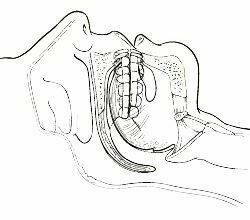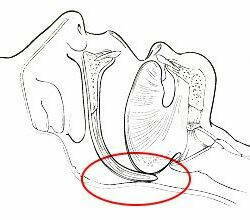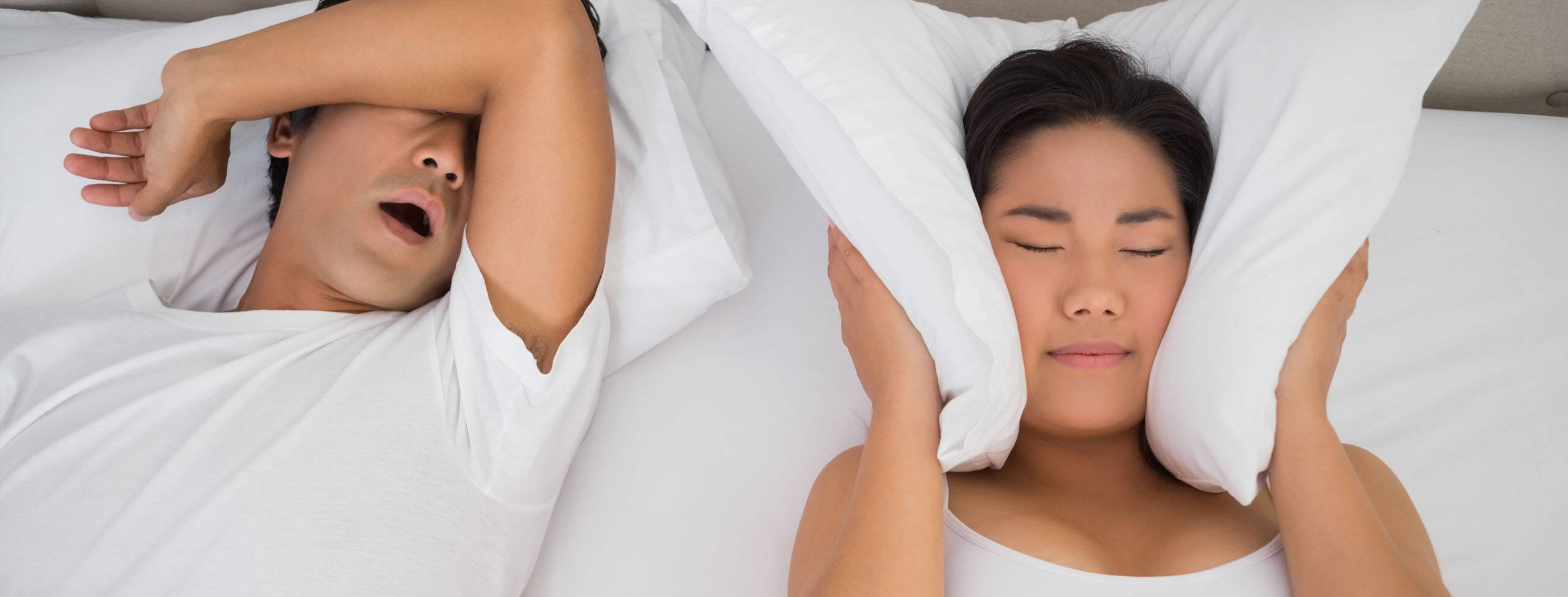Symptoms and Causes of Sleep Apnea and Sleep Apnea-Syndrome
The causes of Obstractive Sleep Apnea (OSA) and Obstractive Sleep Apnea Syndrome (OSAS) are both due to an occlusion of the upper airways during sleep (obstruction). The brief interruption of the oxygen supply leads to a drop in oxygen saturation in the blood.

Open Airways

Closed Airways
Obstructive Sleep Apnea (OSA)
Obstractive Sleep Apnoea (OSA) is caused by repeated obstruction of the upper airway and is the most common form of sleep-related breathing disorder.
With age, body tissue progressively looses its tone and collapses on and off during sleep, blocking the respiratory tract in small intervals. These blockages, called Apnea, are common. If the interruptions of breathing are less than 10 seconds but do not exceed more than 5 times per hour, the Apnea is not yet considered pathological.
Therefore, if the bedroom partner observes irregular snoring with short pauses in breathing, it doesn't mean that you have sleep apnoea. However, it could be a warning signal that with the growing in age, the harmless pauses in breathing could gradually develop into sleep apnea.
For those who who do not qualify for an epensive CPAP therapy after an evaluation in the sleep laboratory, the Velumount method is the ideal, cost-effective way to prevent the development of sleep apnea syndrome.
Obstructive Sleep Apnea Syndrome (OSAS)
About 2 to 4% of the population suffer from obstructive sleep apnea syndrome, around 120,000 people in Switzerland. Usually, the affected have anatomically narrow upper airways which are open while being awake, but are closed during sleep.
The disease is characterized by a complete occlusion of the upper airway during sleep. These respiratory arrests are the main cause for waking you up during sleep (up to 100 times per hour), drop your blood oxygen saturation, and make your heart rate increase. Therefore, the quality of sleep is disturbed resulting in fatique during the day.
Nicotine, alcohol, medication, obesity and the age-related sagging of the soft tissues in the palate further contribute to this process.
OSAS has been prooven to increase the risk of high blood pressure, heart attack, sudden cardiac arrest and stroke, making it a serious medical condition!
If you believe you're suffering from obstructive sleep apnea syndrome, it's highly recommended to consult with a specialist, especially if you suffer from following symptoms.
Symptoms of Sleep Apnea Syndrome
| Frequency | Possible Symptoms |
| very often | not waking up well rested |
| often | repeatedly waking up and grasping for air |
| frequent | bad memory |
| frequent | lack of concentration |
| possible | irritable, depressed, restless |
| possible | libido disorders, impotence |
| possible | urinating frequently at night |
| possible | dry mouth, drooling, teeth grinding |
| possible | night sweats |
| possible | headache upon awakening that gets better during the day |
Treatment options for sleep apnea syndrome
Obstructive sleep apnea syndrome is a serious health condition which not only massively increases the risk of elevated blood pressure, heart attack and stroke, but can also endangers the lives of others if affected individuals sit behind a wheel.
Many aspects must be considered for the treatment of obstructive sleep apnea syndrome. That is why you should always consult a competent specialist. The golden standard of therapy is the nocturnal positive pressure ventilation using a so called CPAP device. The adjustment of the ventilation mask and the correct air pressure etc. requires patience and often needs several adjustment appointments before it has the desired effects.
Some patients suffer from side effects during CPAP ventilation that can't, even with the most careful adjustments, be overcome. These sufferers have a few options, one of them is the Velumount method, a individually fitted brace with which 55% of those affected can expect a reduction of the apnea/hypopnea index by 50%. The Velumount brace mechanically keeps the pharyngeal space open preventing it to collapse.
Nevertheless, a person affected with apnea-hypopnea syndrome using the Velumount method must regularly check the effects of the brace by a professional sleep quality measurment performed by a doctor. The success of the Velumount method in OSAS must always be checked with a Polygraphy!
Central Sleep Apnea (CSA)
In central apnea, the respiratory center doesn't send any signals to breath to the respiratory muscle. Therefore, there are no breathing movements. Central sleep apnea affects only about 5% of the people with sleep apnea.
Various underlying diseases can be the cause for the lack of respiratory signals. Most common are heart conditions and sometimes brain diseases. The Velumount method is not suitable for people suffering of central sleep apnea due to their pre-existing conditions.
It is possible that some patients with obstructive sleep apnea suddenly develop increased central apneas under CPAP therapy. This is referred to as "complex sleep apnea". Presently, there is hardly any data on the frequency of this occurance in patients, however, experts assume on the basis of empirical values that approx. 5-10% of the patients under CPAP therapy are affected by it. For these patients, a medically supervised therapy with the Velumount method can be useful.
Manifestations and severity of sleep apnea
| Habitual snoring | Noisy vibration of the soft tissues caused by constriction and air turbulence in the upper airways |
| OSA | Short pauses in breathing (apneas) during sleep for more than ten seconds more than 10x per hour, with respiratory movements present. Caused by an obstruction (occlusion) of the upper airway. No increased daytime sleepiness. |
| OSAS light | Up to 20 apneas/hour and increased daytime fatigue. |
| OSAS medium | 20-40 apneas/hour and increased daytime fatigue. |
| OSAS severe | More than 40 apneas/hour and increased daytime fatigue. |
| CSA | Breathing pauses for a duration of more than ten seconds in the absence of respiratory movements. Caused by various diseases, usually of the heart (heart failure), sometimes of the brain (stroke, circulatory disorders of the brain). |
| Undine syndrome | Rare, congenital disorder of the central nervous system in which normal autonomic respiratory control during sleep is disrupted. |


